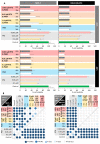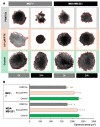Cold Atmospheric Plasma-Activated Media Improve Paclitaxel Efficacy on Breast Cancer Cells in a Combined Treatment Model
- PMID: 35678664
- PMCID: PMC9164030
- DOI: 10.3390/cimb44050135
Cold Atmospheric Plasma-Activated Media Improve Paclitaxel Efficacy on Breast Cancer Cells in a Combined Treatment Model
Abstract
The use of plasma-activated media (PAM), an alternative to direct delivery of cold atmospheric plasma to cancer cells, has recently gained interest in the plasma medicine field. Paclitaxel (PTX) is used as a chemotherapy of choice for various types of breast cancers, which is the leading cause of mortality in females due to cancer. In this study, we evaluated an alternative way to improve anti-cancerous efficiency of PTX by association with PAM, the ultimate achievement being a better outcome in killing tumoral cells at smaller doses of PTX. MCF-7 and MDA-MB-231 cell lines were used, and the outcome was measured by cell viability (MTT assay), the survival rate (clonogenic assay), apoptosis occurrence, and genotoxicity (COMET assay). Treatment consisted of the use of PAM in combination with under IC50 doses of PTX in short- and long-term models. The experimental data showed that PAM had the capacity to improve PTX's cytotoxicity, as viability of the breast cancer cells dropped, an effect maintained in long-term experiments. A higher frequency of apoptotic, dead cells, and DNA fragmentation was registered in cells treated with the combined treatment as compared with those treated only with PT. Overall, PAM had the capacity to amplify the anti-cancerous effect of PTX.
Keywords: DNA damage; PTX; apoptosis; breast cancer cell; cell cytotoxicity; combined therapy; plasma-activated media.
Conflict of interest statement
The authors declare no conflict of interest. The funders had no role in the design of the study; in the collection, analyses, or interpretation of data; in the writing of the manuscript, or in the decision to publish the results.
Figures







References
-
- Gillet J.-P., Gottesman M.M. Mechanisms of Multidrug Resistance in Cancer. In: Zhou J., editor. Multi-Drug Resistance in Cancer. Volume 596. Humana Press; Totowa, NJ, USA: 2010. pp. 47–76. Methods in Molecular Biology. - PubMed
-
- Liu Y., Tan S., Zhang H., Kong X., Ding L., Shen J., Lan Y., Cheng C., Zhu T., Xia W. Selective Effects of Non-Thermal Atmospheric Plasma on Triple-Negative Breast Normal and Carcinoma Cells through Different Cell Signaling Pathways. Sci. Rep. 2017;7 doi: 10.1038/s41598-017-08792-3. - DOI - PMC - PubMed
Grants and funding
LinkOut - more resources
Full Text Sources
Miscellaneous

